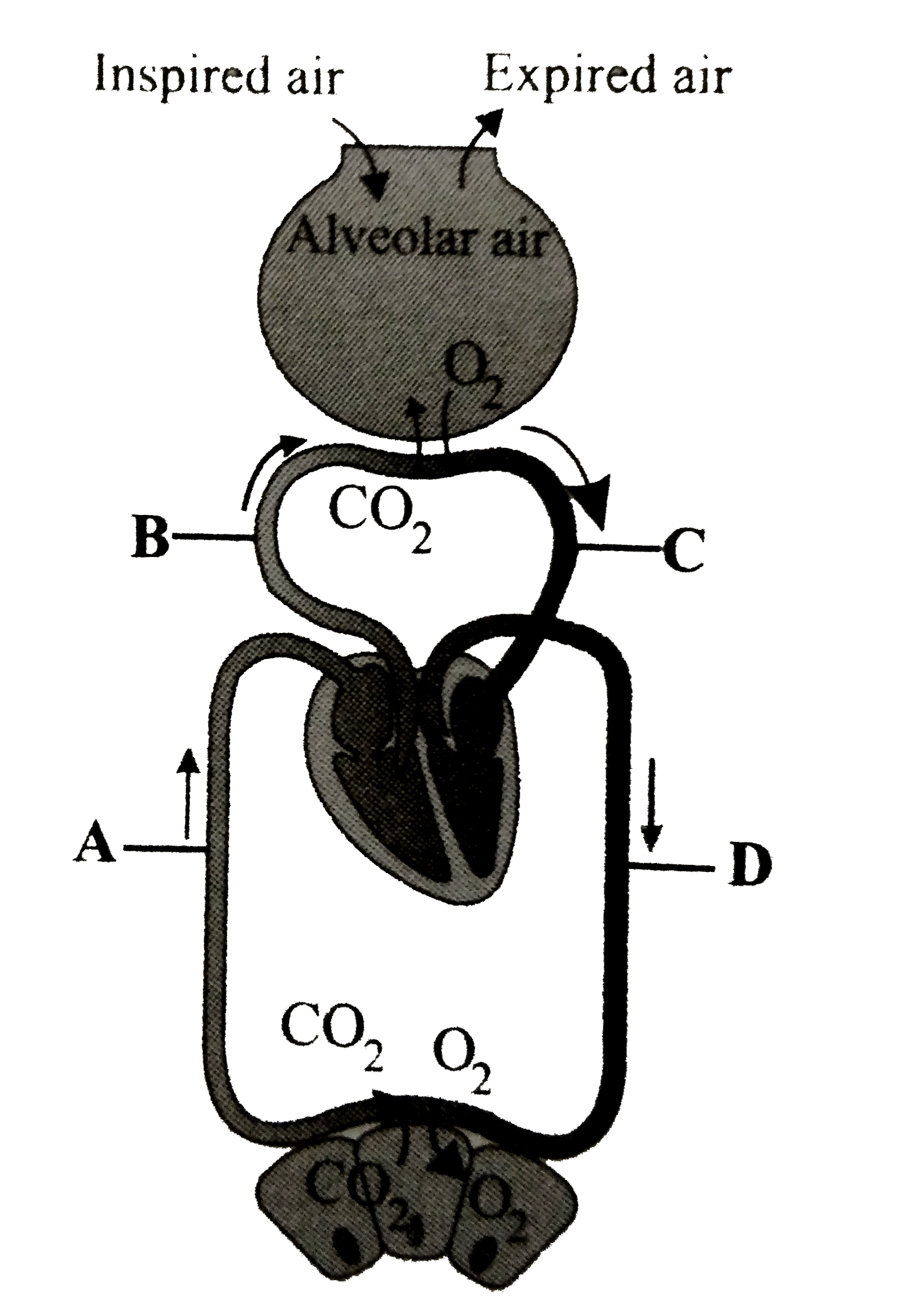What are the modes of exchange of gases at the level of alveoli and tissue respectively ?
Active transport, active transpot
Diffusion, diffusion
Diffusion, active transport
Active transport, diffusion
The correct Answer is:B
To answer the question regarding the modes of exchange of gases (O₂ and CO₂) at the level of alveoli and tissue, we need to understand the processes involved in gas exchange in both locations.
1. Understanding Gas Exchange in Alveoli:
- In the alveoli, oxygen (O₂) from the air enters the bloodstream, while carbon dioxide (CO₂) from the blood is expelled into the alveoli to be exhaled. This exchange occurs due to the difference in concentration gradients.
- The process is driven by diffusion, where gases move from an area of higher concentration to an area of lower concentration. In this case, O₂ moves from the alveoli (high concentration) into the blood (low concentration), and CO₂ moves from the blood (high concentration) into the alveoli (low concentration).
2. Understanding Gas Exchange in Tissues:
- In the tissues, the process is similar. Oxygen (O₂) is delivered from the blood to the tissues, and carbon dioxide (CO₂) produced by cellular metabolism is transported back to the blood.
- This exchange also occurs via diffusion. O₂ diffuses from the blood (high concentration) into the tissues (low concentration), while CO₂ diffuses from the tissues (high concentration) into the blood (low concentration).
3. Conclusion:
- Both the exchange of O₂ and CO₂ at the level of alveoli and tissues occurs through diffusion. Therefore, the correct answer is that the mode of exchange of gases at both the alveoli and tissue levels is diffusion.
Final Answer:
The modes of exchange of gases (O₂ and CO₂) at the level of alveoli and tissue respectively are diffusion for both.
- In the alveoli, oxygen (O₂) from the air enters the bloodstream, while carbon dioxide (CO₂) from the blood is expelled into the alveoli to be exhaled. This exchange occurs due to the difference in concentration gradients.
- The process is driven by diffusion, where gases move from an area of higher concentration to an area of lower concentration. In this case, O₂ moves from the alveoli (high concentration) into the blood (low concentration), and CO₂ moves from the blood (high concentration) into the alveoli (low concentration).
- In the tissues, the process is similar. Oxygen (O₂) is delivered from the blood to the tissues, and carbon dioxide (CO₂) produced by cellular metabolism is transported back to the blood.
- This exchange also occurs via diffusion. O₂ diffuses from the blood (high concentration) into the tissues (low concentration), while CO₂ diffuses from the tissues (high concentration) into the blood (low concentration).
- Both the exchange of O₂ and CO₂ at the level of alveoli and tissues occurs through diffusion. Therefore, the correct answer is that the mode of exchange of gases at both the alveoli and tissue levels is diffusion.
The modes of exchange of gases (O₂ and CO₂) at the level of alveoli and tissue respectively are diffusion for both.
Similar Questions
Knowledge Check
The exchange of gases in the alveoli of the lungs takes place by
Apassive transportBactive transportCosmosisDsimple diffusion.The given figure shows the diagrammatic represtation of exchange of gases at the alveolus and the body tissues with blood and trasport of oxygen and carbon dioxide. Identify the blood vessles A to D.
 AABCDSystemic veinPulmonary arteryPulmonary veinSystemic arteryBABCDSystemic arteryPulmonary arteryPulmonary veinSystemic veinCABCDPulmonary arterySystemic veinPulmonary veinSystemic veinDABCDSystemic veinPulmonary veinPulmonary arterySystemic artery
AABCDSystemic veinPulmonary arteryPulmonary veinSystemic arteryBABCDSystemic arteryPulmonary arteryPulmonary veinSystemic veinCABCDPulmonary arterySystemic veinPulmonary veinSystemic veinDABCDSystemic veinPulmonary veinPulmonary arterySystemic arteryGiven below is a list of different steps (i-vi) involved in respiration.
(i) Utilisation of O2 by the cells for catabolic reactions.
(ii) Transport of gases by the blood.
(iii) Pulmonary ventilation by which atmospheric air is drawn in and CO2 is released out.
(iv) Release of resultant CO2.
(v) Diffusion of O2 and CO2 between blood and tissues.
(vi) Diffusion of gases (O2 and CO2) across alveolar tissues.
Select an option which has correct sequence of all the steps.A(iii),(vi),(ii),(v),(i),(iv)B(iii),(vi),(i),(v),(ii),(iv)C(iv),(ii),(v),(iii),(i),(vi)D(iv),(vi),(ii),(v),(i),(iii)
Explain the transport of O2 and CO2 between alveoli and tissue with diagram.
View SolutionState the importance of the solubility of CO2 and O2 in water.
View SolutionExplain the transport of O2 and CO2 between alveoli tissue with diagram.
View SolutionHow are gases like O2andCO2 exchanged in our body ?
View SolutionGiven below is a list of different steps (i-vi) involved in respiration.
(i) Utilisation of O2 by the cells for cataolic reactions.
(ii) Transport of gases by the blood.
(iii) Pulmonary ventilation by which atmospheric air is drawn in and CO2 is released out.
(iv) Release of resultant CO2.
(v) Diffusion of O2 and CO2 between blood and tissues.
(vi) Diffusion of gases (O2 and CO2) across alveolar tissues.
Select an option which has correct sequence of all the steps.
View Solution
